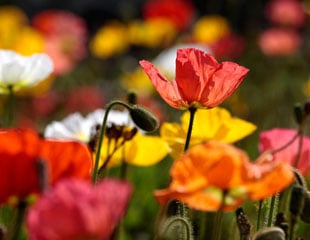
Icelandic Poppy
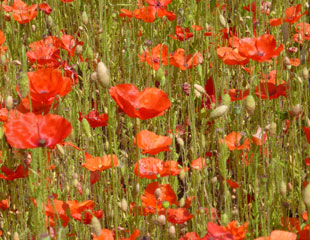
Corn Poppy
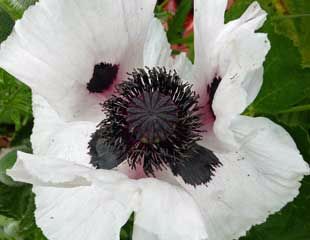
Oriental Poppy
How to Grow Poppies
Although around 70 poppy species exist, we gardeners commonly grow only a few varieties.
Illustrated are the three main types of Poppy : Icelandic, Corn and Oriental Poppy. Although all poppies they have very different growing requirements.
Icelandic poppies are treated as annuals, the corn poppy is an annual and both will self seed around the garden in good growing conditions. Both are easy to grow from seed. Sow the seed close to the surface, where the plants are to grow and in a sunny spot. Neither poppy needs good soil. They will grow in poor soil as a wild/semi wild plant.
Oriental poppies are (usually) perennial with large bright flowers tend to be short-lived.
Annual poppies
We also know this Poppy as Field, Flanders and Corn poppy. This red poppy grows wild along field edges, creating swathes of bright red. Recently, the annual ladybird poppy (image below right) has become popular, which is not dissimilar to the field poppy, but with ladybird type markings.
This type of Poppy prefers well drained, poor soil and full sun. As an annual, it has to be sown each year, from March to May on soil which is well raked fine soil and seed directly into the soil. As with all seeds, ensure that the tiny seedlings do not dry out. Poppies will self seed but not always reliably as successful germination is dependent on the growing conditions.
Dry fine soil is important for annual re seeding. The annual field poppy is commonly seen growing in fields in the drier parts of the UK such as Dorset and the East. The drought of 2018 caused the poppy to put in an appearance much further north with the drier conditions.
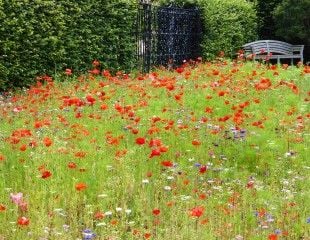
Poppy in wildflower setting
Poppies look attractive in a natural setting with wildflowers and this is the annual poppy which would be seeded each year with the wildflower seeds
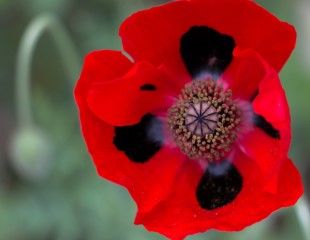
Ladybird Poppy
This variety of poppy has become popular because of it has attractive inner markings similar to a ladybird. This is also an annual poppy, which means it needs to be re seeded each year.
Perennial Poppies
There are two types of popular perennial poppies; Icelandic and Oriental. It's difficult to decide into which group to put Icelandic poppies. They are technically perennial, but treated as annuals either way they will self seed.
The Icelandic Poppy, illustrated top left and Oriental Poppies top right, also prefer soil on the dry side which is well drained, and with plenty of sun. The Icelandic poppy, although not from Iceland, it developed from a species originating in cold arctic areas and as such Icelandic poppies prefer cooler growing conditions. They are fully hardy, a smaller poppy growing upwards to 30cms or 12". As with all poppies, the flowers are short-lived and blooms are yellow, white, and orange. It is very colourful and makes a great splash of colour in the border. Easy to grow and freely self seeding it reappears in borders from year to year.
Shown top right is Papaver Orientale, the oriental poppy, originates from Turkey and Iran and is a big blousy poppy with lots of style and colour. Easy to grow, it has much larger flowers and is a short-lived perennial. It will tolerate a damper soil than the other two varieties. Whereas some poppies are annual and biennials, the Oriental Poppy is perennial.
The Oriental Poppy flowers from late spring to early summer, with each stem supporting one large flower. This poppy also likes to be planted in a sunny spot to flower well, but is otherwise is not fussy about conditions. The oriental poppy has large flower heads which tend to bit floppy with a risk it will overlay other plants if not staked. The Oriental poppy is a keen seeder and you will soon have other clumps emerging. The one down side is that the leaves die back on the Oriental Poppy after flowering which can leave a gap in the border. It is possible to get a second flush of flowers by cutting back the flower stems on Papaver Orientale as soon as it has flowered, cut right back to the ground level. Oriental poppies are suitable for the middle of the border, medium height around 45cm - 90cms. Oriental poppies are easy to grow and reliable flowering plants.
If poppies are not the flower for you take a look at Spring and Summer flowering plants.
How to grow Meconopsis, common name Himalayan Blue Poppy
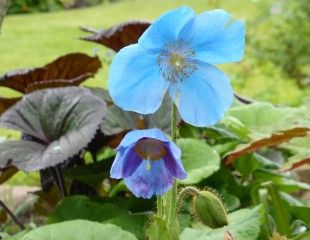
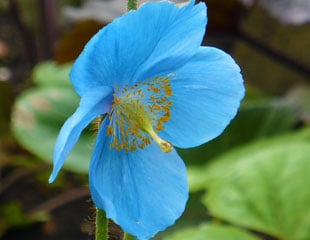
The image above is of the exotic blue poppy called Meconopsis, common name Himalayan Blue Poppy. It is very particular about growing conditions which need to be cool and shady with a damp well drained soil. It is a beautiful Poppy, and it is also the exception to the rule that poppies are easy to grow. Meconopsis poppies are correctly considered difficult to grow, thriving best in cooler areas of Northern Britain and Scotland. It is most suited to woodland settings and damp conditions.
Meconopsis Grandis 'Branklyn' the Himalayan Blue Poppy is a stunning plant, but it is very particular about its growing conditions and can be short lived. It needs a sheltered shady spot in moist, acid soil. It will not tolerate warm dry spots. It is a native of Tibet where summers are cool and wet, and winters cold and snowy, which are the conditions it is best suited to. It is ideal in a woodland garden, a shady area and will tolerate coastal conditions. Meconopsis grow to around 1m, it is summer flowering and fully hardy. Meconopsis can short lived and if grown in a dry spot will be Monocarpic, i.e. die after first flowering, so the right spot is crucial.
Some varieties are Monocarpic by nature and so selecting a variety is important. M. betonicifolia and grandis are not by nature monocarpic and have the RHS garden merit award and would make a good choice. Recommended varieties with award of garden merit are M. baileyi, M 'Jimmy Bane', M. 'Huntfield' and M. 'Barney's Blue'
